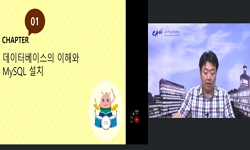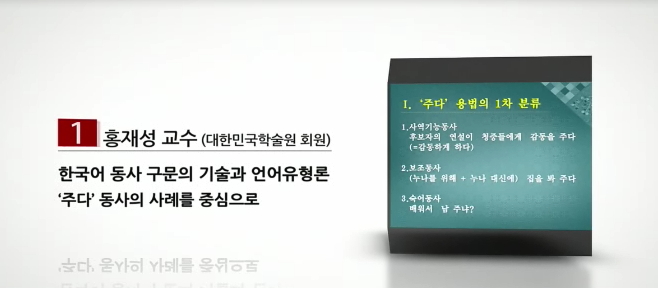This article surveyed the compilation process and the main characteristics of Gosijo Daejeon (Unabridged Dictionary of Classical Sijo). The compilation of Gosijo Daejeon have started from 1990 and finished in July 30, 2012 after 23 years of long time....
http://chineseinput.net/에서 pinyin(병음)방식으로 중국어를 변환할 수 있습니다.
변환된 중국어를 복사하여 사용하시면 됩니다.
- 中文 을 입력하시려면 zhongwen을 입력하시고 space를누르시면됩니다.
- 北京 을 입력하시려면 beijing을 입력하시고 space를 누르시면 됩니다.
https://www.riss.kr/link?id=A102135257
- 저자
- 발행기관
- 학술지명
- 권호사항
-
발행연도
2012
-
작성언어
-
-
주제어
고시조 대전 ; 고시조 ; 가집 ; 데이터베이스 ; 문헌집성 ; 유형 ; 군집 ; 대교 ; 對校 ; 정보처리 ; Gosijo Daejeon ; classical sijo ; gajib(collection of sijos) ; database ; collection of literature ; types ; groups ; collation and correction ; data processing
-
KDC
900
-
등재정보
KCI등재
-
자료형태
학술저널
-
수록면
433-474(42쪽)
-
KCI 피인용횟수
2
- 제공처
-
0
상세조회 -
0
다운로드
부가정보
다국어 초록 (Multilingual Abstract)
This article surveyed the compilation process and the main characteristics of Gosijo Daejeon (Unabridged Dictionary of Classical Sijo). The compilation of Gosijo Daejeon have started from 1990 and finished in July 30, 2012 after 23 years of long time. Gosijo Daejeon is the collection of collated and corrected 46,431 sijos from 316 kinds of classical sijo literatures, and it categorized collected sijos into 5,563 types and 6,845 groups. In the second chapter, the compilation process of Gosijo Daejeon was described in three stages. Establishment and applied research of the primary database (1990-2006) Compilation and genealogical study of the texts (2007-2010) Publication of the secondary database (2010-2012) The first stage was the period that the database of classical sijos were planned, and 5,180 numbers of classical sijos were electronic-textualized so that classical sijo searching system became possible. Also, the concept of thematic elements were introduced to the applied researches utilizing classical sijo database. The second stage was the period that “the compilation and genealogical study of classical sijo, the period of enlightenment sijo, modern sijo texts” were conducted with the fund from National Research Founation of Korea in 2007. In this chapter, the collecting of classical sijo literatures and its electonic-textualization process were introduced in detail. The last stage was the period that databased classical sijos were categorized into types and groups after the collating and correcting, the information of author and music were regularized, and finally Gosijo Daejeon were completed. In the third chapter of this article, main characteristics of Gosijo Daejeon were depicted. In this chapter, including range and scale of Gosijo Daejeon was presented, the notions of types and group which were the most important features of Gosijo Daejeon, arranged order of texts within the types and groups, and the issue regarding normalization of the title piece were discussed. Also, the way collateral information of the texts such as author, melody, title were presented in Gosijo Daejeon was narrated. Besides, subsidiary information on the group of texts (proximate groups of texts, translation) and the details in the appendix (Chinese poems translated into Korean, introductions, and information of authors) were presented.
참고문헌 (Reference)
1 신경숙, "하순일 편집 '가곡원류'의 성립" 한국시조학회 (26) : 125-150, 2007
2 김흥규, "컴퓨터에 의한 古時調 데이터베이스 구성과 활용" 동아인문학회 (3) : 1992
3 김흥규, "색인어 정보 연산에 의한 고시조 데이터베이스의 분석적 연구" 한국시가학회 3 : 1998
4 김흥규, "고시조대전" 고려대학교 민족문화연구원 2012
5 신경숙, "고시조 문헌 해제" 고려대학교 민족문화연구원 2012
6 김흥규, "고시조 데이터베이스의 계량적 분석과 시조사의 지형도" 고려대학교 민족문화연구원 2002
7 권순회, "歌曲과 時調의 접점: 신발굴 가집 『歌詞』의 특성과 계보" 국문학회 (23) : 119-142, 2011
8 김흥규, "朝鮮 後期 辭說時調의 詩的 關心 推移에 관한 計量的 分析" 一志社 73 : 1993
9 김흥규, "古時調 內容素의 분포 분석과 시조사적 고찰" 고려대학교 민족문화연구원 1-277, 2006
10 이상원, "『청구영언』(가람본)의 성격과 계보학적 위상" 고전문학한문학연구학회 9 : 159-194, 2010
1 신경숙, "하순일 편집 '가곡원류'의 성립" 한국시조학회 (26) : 125-150, 2007
2 김흥규, "컴퓨터에 의한 古時調 데이터베이스 구성과 활용" 동아인문학회 (3) : 1992
3 김흥규, "색인어 정보 연산에 의한 고시조 데이터베이스의 분석적 연구" 한국시가학회 3 : 1998
4 김흥규, "고시조대전" 고려대학교 민족문화연구원 2012
5 신경숙, "고시조 문헌 해제" 고려대학교 민족문화연구원 2012
6 김흥규, "고시조 데이터베이스의 계량적 분석과 시조사의 지형도" 고려대학교 민족문화연구원 2002
7 권순회, "歌曲과 時調의 접점: 신발굴 가집 『歌詞』의 특성과 계보" 국문학회 (23) : 119-142, 2011
8 김흥규, "朝鮮 後期 辭說時調의 詩的 關心 推移에 관한 計量的 分析" 一志社 73 : 1993
9 김흥규, "古時調 內容素의 분포 분석과 시조사적 고찰" 고려대학교 민족문화연구원 1-277, 2006
10 이상원, "『청구영언』(가람본)의 성격과 계보학적 위상" 고전문학한문학연구학회 9 : 159-194, 2010
11 이상원, "『남훈태평가』의 필사본 유통 양상" 한국시가학회 27 : 185-220, 2009
12 이상원, "『개호잡록(開湖雜錄)』에 대하여" 인문학연구원 (40) : 217-262, 2010
13 이상원, "『가조별람』의 문헌적 특성과 시가와의 관계" 한민족어문학회 (54) : 5-38, 2009
14 신경숙, "『가곡원류』 편찬 연대 재고" 한민족어문학회 (54) : 71-100, 2009
15 권순회, "『海東歌譜』(전북대 소장)의 性格" 한국시조학회 (28) : 229-261, 2008
16 권순회, "『時調音律』의 편제와 가곡의 특성" 한국언어문학회 66 (66): 111-125, 2008
17 권순회, "『古今歌曲』의 원본 발굴과 轉寫 경로" 우리어문학회 (34) : 129-160, 2009
18 권순회, "19세기 전반 가곡 가집『詩歌曲』의 특성과 계보" 한국시가학회 29 : 157-179, 2010
19 신경숙, "19세기 말 가집『聲樂元祖 歌曲』의 성격" 한국시가학회 29 : 209-234, 2010
동일학술지(권/호) 다른 논문
-
탈근대, 탈식민, 탈민족 포스트 담론 20년의 성찰 ‘포스트’ 담론의 유령들 -애도의 애도를 위하여-
- 고려대학교 민족문화연구원
- 진태원 ( Tae Won Jin )
- 2012
- KCI등재
-
탈근대, 탈식민, 탈민족 포스트 담론 20년의 성찰 한국에서 포스트맑스주의의 수용 과정과 쟁점들
- 고려대학교 민족문화연구원
- 김정한 ( Jung Han Kim )
- 2012
- KCI등재
-
탈근대, 탈식민, 탈민족 포스트 담론 20년의 성찰 포스트사회과학 사회적인 것의 과학, 그 이후?
- 고려대학교 민족문화연구원
- 서동진 ( Dong Jin Seo )
- 2012
- KCI등재
-
탈근대, 탈식민, 탈민족 포스트 담론 20년의 성찰 문학의 탈정치화와 포스트 담론의 파장 -민주화 이후 한국문학의 전개와 쇠락
- 고려대학교 민족문화연구원
- 이명원 ( Myung Won Lee )
- 2012
- KCI등재
분석정보
인용정보 인용지수 설명보기
학술지 이력
| 연월일 | 이력구분 | 이력상세 | 등재구분 |
|---|---|---|---|
| 2026 | 평가예정 | 재인증평가 신청대상 (재인증) | |
| 2020-01-01 | 평가 | 등재학술지 유지 (재인증) |  |
| 2017-01-01 | 평가 | 등재학술지 유지 (계속평가) |  |
| 2015-03-17 | 학술지명변경 | 외국어명 : 미등록 -> Korean Cultural Studies |  |
| 2013-01-01 | 평가 | 등재 1차 FAIL (등재유지) |  |
| 2010-01-01 | 평가 | 등재학술지 유지 (등재유지) |  |
| 2009-06-18 | 학회명변경 | 영문명 : Institute of Korean Culture -> Research Institute of Korean Studies |  |
| 2008-01-01 | 평가 | 등재학술지 유지 (등재유지) |  |
| 2005-10-18 | 학술지명변경 | 한글명 : 민족문화연구 29호 -> 민족문화연구 |  |
| 2005-01-01 | 평가 | 등재학술지 선정 (등재후보2차) |  |
| 2004-01-01 | 평가 | 등재후보 1차 PASS (등재후보1차) |  |
| 2002-01-01 | 평가 | 등재후보학술지 선정 (신규평가) |  |
학술지 인용정보
| 기준연도 | WOS-KCI 통합IF(2년) | KCIF(2년) | KCIF(3년) |
|---|---|---|---|
| 2016 | 0.77 | 0.77 | 0.7 |
| KCIF(4년) | KCIF(5년) | 중심성지수(3년) | 즉시성지수 |
| 0.71 | 0.7 | 1.385 | 0.15 |




 KCI
KCI KISS
KISS






